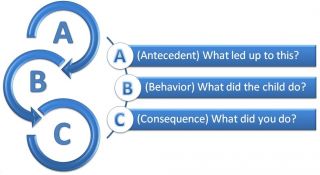Stress
The ABCs of Child Behavior
Analyze your child's behavior to learn how to shape it in a positive direction.
Posted September 1, 2015

As a parent, you want your child to behave in certain ways – smart, fun, polite, careful. Sometimes, they do, but other times… well, let’s just say s/he made the wrong choice. And so, you need to let him/her know what type of behavior is appropriate and what is not.
But first, you need to understand the psychology behind your child’s behaviors, and then you can start to move it in a more positive direction. For kids, behavior is communication; it’s their way of saying, “I want this,” or, “I don’t like that.”
When psychologists analyze a behavior, they think in terms of the ABC formula: Antecedent, Behavior, and Consequence. Just about every behavior, both positive and negative, follows this pattern.

Antecedent: the buildup of events, the contributing factors, and sometimes the triggers that lead to your child’s behavior.
Behavior: the response your child has in reaction to the antecedent.
Consequence: what happens after the behavior that makes it more or less likely the behavior will occur again.
To handle behavior issues, parents should first take a deep, calming breath, and then frame their thinking around these ABCs.
1. First, consider those antecedents, or triggers, that led up to the behavior. There are a million possibilities, of course, but here are some common age-based examples:
Toddlers: If she’s having a tantrum, consider whether she’s hungry, tired or frustrated—by far, the three biggest antecedents of tantrums.
School-Aged Kids: When he pushes his brother, figure out whether it happened in trying to get to something first or if he did it out of anger.
Teens: If she starts mouthing off to you, look around and see if that tends to happen more in a particular setting or when a specific friend is around.
2. Next, focus on the specific actions you want to change:
Toddlers: If she grabs toys and doesn’t let anyone else at the playdate use them, focus on the specific actions involved in sharing: handing items to someone else, looking around to see the other toy choices nearby, saying please and thank you.
School-Aged Kids: If he throws his hands up in frustration every night during homework time, keep the attention on putting in good effort – for the moment, don’t focus on the assignment’s grade.
Teens: Rolled eyes and slammed doors just seem to be ubiquitous with teens. While you may not be able to get them to immediately change their attitude (which is developmentally appropriate, by the way), you can insist they “try that again” and not door-slam or eye-roll.
3. Then, choose an appropriate consequence. Many parents go straight to punishments, but there are many other potential consequences that influence whether the behavior is repeated. Here are some of the most common, or most effective, along with the reasons why they work so well!
Many parents immediately go to a Time-Out, but that doesn’t work unless he experiences Time-In—positive together time. That’s the only leverage that makes Time-Out work as a consequence, so make sure your child is getting enough.
Play off their tendency to copy-cat by role-modeling good behavior. If she mimics something you don’t want her to, own up to it, explain that you don’t want her doing it, and then make sure you stop doing it!
Use when/then statements: “When you put away all these toys, then we can go to the park.” This is both an easily-followed direction, as well as a positive reinforcement for good behavior.
Enforce limits, rules and expectations consistently, so he knows what happens when he behaves a certain way.
Has she ever had a tantrum in an empty room? Waited to roll her eyes until you’re looking? The point of these behaviors is attention. Sometimes ignoring is your best tactic.
Don’t give in! That only sets you up for repeated bad behavior.
If you instill a punishment or negative consequence, make sure it’s immediate, specific, and within the context of the behavior you’re trying to stop. Don’t overdo it just because you’re mad.
Praise good behavior whenever you see it, because the ABCs apply there, too. When your child gets positive reinforcement as a consequence for doing something right, he or she is more likely to do that again!
Now, this is a long list, so don’t let it overwhelm you. Ease into it by first thinking through the ABCs of the last couple of problem behaviors at your house. What contributed to those problems? How could you have controlled the antecedents better? Did your consequences make it more or less likely the behavior will happen again? What might have happened if you’d reacted differently?
After that exercise, it will be easier to remember the ABCs in the heat of the moment. Keep an eye out for patterns that are clues to those ABCs. Pretty soon, using the ABCs of behavior will become intuitive: they are the keys to unlocking your family's stress-free discipline plan.
Copyright: Dr. Peter L. Stavinoha & Sara Au




